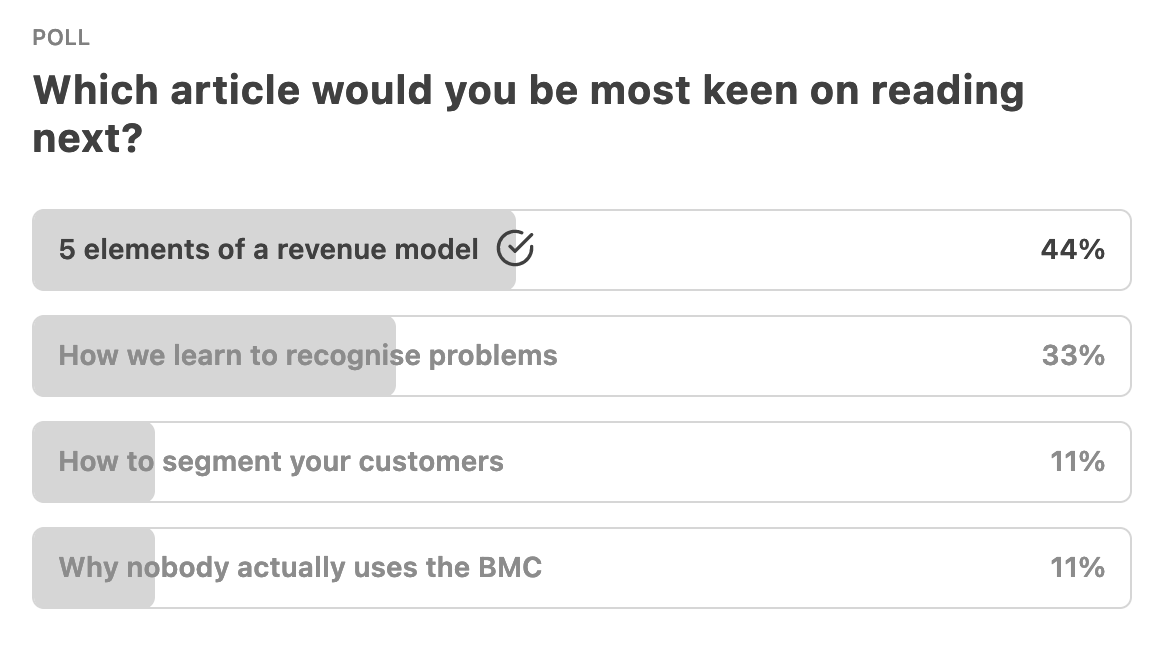In the last edition, you voted for ‘5 elements of a revenue model’. Let’s go.
💰5 elements of a revenue model
What is a revenue model?
A business model is the way you generate & capture value
A revenue model is the way you capture value
Yes, a lot of people say business model when they actually mean revenue model. That’s okay.
5 elements of your revenue model
1. What is value, and for whom?
If you want to nail your revenue model, you need to research how customers see your value.
Who is getting value from your solution?

What is hard about this?
It takes time and effort to clearly understand the value your provide
Some values are more challenging to quantify than others. “Status” is a vague value, “time saved” is quantifiable and easier to put a value on.
Ask your users: “Why is this of value to you?”. Listen carefully.
Don’t skip this step and say: ‘We know our customer’. Plan at least 30 customer interviews to get a sense of value.
2. Who is paying for this value being generated?
End-user is paying the customer
You buy your coffee
You have a monthly Spotify subscription
A related user is paying
Your CEO pays for your team’s Slack subscription
Your ex pays for your Netflix subscription 😈
3rd party is paying
Airbnb charges you a fee to give to the hosting party
Advertisers pay Google for free search for you
Governments pay companies to erect roads for citizens to use
What is hard about this
For most B2C startups, this is quite clear: consumer pays.
For B2B it’s often a process of figuring out who in the company is allowed to spend money on you.
In social ventures or business to government (B2G) it can be even harder to find the person that is willing to pay for the value generated because it is more scattered (example below).
Also for MedTech, this is a common issue, insurers pay, not the end-user.
I once mentored a social venture that wanted to increase voter turn-out among young adults with a clever solution. Young adults are among the least voting people. They don’t care about politics. They will surely not pay for a solution for something they don’t care about.
The startup needed to find a 3rd party who was interested in this and found this in a government worker that was responsible for participatory democracy. He cared and was willing to spend money on a pilot. Solution appeared not to be working, so pilot never launched.
3. What is your price build-up?
Fixed costs per unit
Hardware
Apple iPhone (SE/Ultra/MAX) $450 - $800
Coffee (S/M/L) - $3-$6
Services
Hairdresser (Beard, Beard + Hair, Beard + Hair + Washing)
Single feature/software
Remove ads from app ($2 one-time fee)
Affinity Photo 2 ($80 one-time fee)
Adobe CC ($20 monthly Subscription)
Variable cost
Pay per time unit
Freelancer per hour ($100 / hour)
Lime per minute use ($0.50 / minute)
Pay per feature (tier)
Slack Premium ($5 / user / month)
Pay per usage
AWS Glacier storage ($0.1 / GB / month)
Pay per KG
UPS ($5-$500 per parcel)
Pay per distance
Uber ($5-150 per ride)
Public transport
What is hard about this?
If you are entering a mature market, price buildup often has a ‘dominant design’, e.g. paying per user per month is very common in SaaS. You don’t need to innovate on this, if it works it works.
For SaaS, it’s hard to figure out which aspects of your software to make paid. Reverse trial is something to check out (read more on this experiment on three trial models)
4. When do you charge?
Subscription
Weekly
Newspaper
Monthly
Most SaaS
Seasonally
Ski-resort tickets
Football stadium tickets
One-time purchases
After use
Uber, Lime, Freelancers
Before use
Apple MacBook Pro, Booking.com, Airbnb
What is hard about this?
How often does your customer get value? Continuously or once every month? You need to have this information.
Don’t overcomplicate this. Remember the subscription craze a while back? Who needs a peanut butter subscription?
There’s a dominant design for a reason. People are used to buying these things.
5. How much do you charge?
Pricing is an art. You want to find the ideal spot between the value you generate and the costs you make.
What is hard about this?
Startups often forget to optimise pricing while this can yield the highest results.
Many startups, especially new SaaS, enter the market with a cost-cutting strategy. This might not be a sustainable strategy.
Price elasticity is a thing. I might be missing out on clients because of the rate I charge.
Consume these before setting your price
14 pricing strategies as per Hubspot (or these 5)
Get more pricing experiment ideas from Monetising innovation
31 revenue models cheat sheet
Which topic should go next?
Thanks for voting last time, keeps me motivated!








